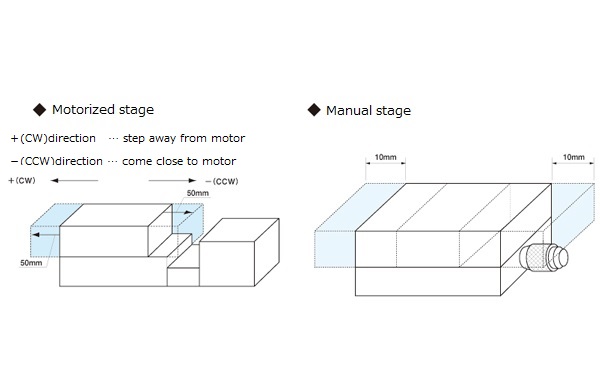Dimensions / tolerances / drawings / material
- Position of the stage carriage in the drawings (center of the travel range)
- As the installation space of the stage is limited, I am concerned about the maximum length
of the stage with full stroke.
Is the position of the stage carriage in the drawings at the center of the travel range? -

In principle, all the drawings of stages show when carriages are in the center of the travel ranges.
◆ Motorized Stage
The travel range represents the full travel length.
For example, in the case of 100 mm, centering on the position shown in the trace diagram,
the stage move 50mm in positive direction (CW) and 50mm in negative direction (CCW)
◆ Manual Stage
The travel range is indicated by +/- from the center. For example, in the case of +/-10mm,
centering on the position shown in the trace diagram, the stage move 10mm in negative direction
and 10mm in positive direction(* full travel length is 20mm)
[exception]
There is an exception in manual Z-axis stages.
In that case, rather than showing travel range by +/-, it shows travel range in each of positive
and negative directions.
- [Stage height - dimensional tolerance] PG413-L24
- What is the height tolerance of the motorized X-axis stage (PG413-L24AG/body part)?
-
It is equivalent to general dimension torelance midium grade, against the height of main body
excluding motor (20mm).
- KS451-40 φ8mm through hole
- In the dimensional drawing of the KS 451-40, it is described as “transmission hole diameter φ8 (H7)”
at the center of the stage carriage.
Is it good to recognize that this transmission hole is a φ8 mm transmission hole with the center
of the stage carriage and the main body aligned? -
Although it is described as φ8 mm, in fact, the diameter of stage carriage is φ8.2
and that of the main body section is φ8mm.
Also, the central axis of the transmission hole is not aligned with the transmission hole
on the stage carriage.
Therefore, the diameter of the stage carriage is larger than the reference transmission hole.